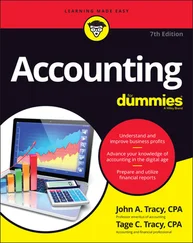Kenneth W. Boyd - Cost Accounting For Dummies
Здесь есть возможность читать онлайн «Kenneth W. Boyd - Cost Accounting For Dummies» — ознакомительный отрывок электронной книги совершенно бесплатно, а после прочтения отрывка купить полную версию. В некоторых случаях можно слушать аудио, скачать через торрент в формате fb2 и присутствует краткое содержание. Жанр: unrecognised, на английском языке. Описание произведения, (предисловие) а так же отзывы посетителей доступны на портале библиотеки ЛибКат.
- Название:Cost Accounting For Dummies
- Автор:
- Жанр:
- Год:неизвестен
- ISBN:нет данных
- Рейтинг книги:4 / 5. Голосов: 1
-
Избранное:Добавить в избранное
- Отзывы:
-
Ваша оценка:
- 80
- 1
- 2
- 3
- 4
- 5
Cost Accounting For Dummies: краткое содержание, описание и аннотация
Предлагаем к чтению аннотацию, описание, краткое содержание или предисловие (зависит от того, что написал сам автор книги «Cost Accounting For Dummies»). Если вы не нашли необходимую информацию о книге — напишите в комментариях, мы постараемся отыскать её.
Cost Accounting For Dummies
Cost Accounting For Dummies
Cost Accounting For Dummies — читать онлайн ознакомительный отрывок
Ниже представлен текст книги, разбитый по страницам. Система сохранения места последней прочитанной страницы, позволяет с удобством читать онлайн бесплатно книгу «Cost Accounting For Dummies», без необходимости каждый раз заново искать на чём Вы остановились. Поставьте закладку, и сможете в любой момент перейти на страницу, на которой закончили чтение.
Интервал:
Закладка:
Mulling over fixed and variable costs
Total fixed costs don’t change when your level of production or sales changes. On the other hand, total variable costs do change with the level of production or sales.
Kicking around fixed costs
Consider a lease payment for a piece of equipment. Whether your production increases or decreases, the check you write for the lease stays the same. The cost is fixed in your lease agreement.
Say the lease payment is $500 per month, and that you manufacture office desks. You can’t directly trace the lease payment to the product you produce — the cost is indirect. So you allocate the lease payment cost to each desk you produce. In March you produce 1,000 desks. The equipment lease is $500 ÷ 1,000 desks, or $0.50 per desk.
In April, you make 800 desks. The April equipment lease is $500 ÷ 800 desks, or $0.63 per desk. Because you produce fewer desks in April but the lease payment doesn’t change, you allocate a larger cost per unit (desk).
There’s a difference between total fixed costs and the fixed costs per unit. The total fixed costs don’t change with your activity level. Fixed costs per unit do change as your production level goes up or down. As a strategy, businesses aim to produce and sell as much as they can for the same amount of fixed costs. That strategy generates the lowest possible fixed cost per unit.
Computing variable costs
Total variable costs change in total with your level of production. Say you use plywood to make each office desk. Each desk requires $4 of plywood. The $4 cost per desk does not change with production.
If you produced 1,000 desks in March, your total variable plywood cost is 1,000 desks × $4, or $4,000. The 800 desks produced in April generate $3,200 in variable plywood costs. The total variable costs do change, but the $4 variable cost per unit stays the same.
Table 2-1summarizes fixed and variable costs.
TABLE 2-1:Fixed and Variable Costs
| Change with Level of Production? | |
|---|---|
| Fixed Costs | |
| Total fixed costs | No |
| Fixed cost per unit | Yes |
| Variable costs | |
| Total variable costs | Yes |
| Variable cost per unit | No |
Fitting the costs together
This section explains how direct costs, indirect costs, fixed costs, and variable costs all fit together. One simple way to explain the relationship is to go over some examples. Table 2-2shows you an example of four types of costs.
TABLE 2-2:Fixed and Variable Costs, Direct and Indirect Costs — Examples
| Direct Cost | Indirect Cost | |
|---|---|---|
| Fixed costs | Hourly union wages | Equipment lease |
| Variable costs | Material and labor cost | Factory utility costs |
Table 2-2is a new territory. Each cost can be classified as either direct or indirect and either fixed or variable. Let’s go through the examples one at a time.
Say you manage a factory. You pay wages to hourly workers based on a union contract. The contract states the number of hours each employee works and their pay rate per hour. The total wages paid is a fixed cost. The cost is also a direct cost. That’s because the only reason to have hourly workers is because you’re producing a product. No production, no hourly workers — and no cost.
In the section “ Kicking around fixed costs,” you work with an equipment lease. Because the equipment is used to make a product, the lease is a fixed, indirect cost. You allocate the indirect cost based on the number of units (desks) created.
Material and direct labor costs are addressed in the section “ Comparing direct and indirect costs.” Those are variable costs that change (in total) with your level of production.
If you manage a factory, you incur utility costs to heat, cool, and provide power to the factory. The more products you produce, the more utility costs you incur. So utility costs can vary with the level of activity.
Utility costs are also indirect costs. Because you can’t trace the costs directly to a product, you have to allocate them. Utility costs are often allocated using labor hours for a particular time period.
Covering Costs in Different Industries
In the Introduction, I note that this book covers both products and services. A product is a physical item that your customer can touch, see, and feel. When a customer pays you for doing something — such as cleaning an office or driving a product from point A to point B — that’s a service. The way customers interact with your business also determines the type of costs you incur. Do you have a physical store or site location, sell online, or both?
Reviewing manufacturing costs
Manufacturers make products. They incur material and labor costs, as well as overhead.
No manufacturer can produce a product instantly. When you close the factory doors for the night, you have partially completed goods on hand. Those products are called work-in-process ( WIP ) .
Assume you make blue jeans. The jean production moves from one department to another. Say that the denim material has been cut for 100 pairs of jeans. The next step is to sew the denim and then dye the material. You close your factory doors before the jeans move to the sewing department.
Consider the cost you’ve incurred on the jeans. You purchased the denim, a material cost. You paid your workers to run machines to cut the denim (labor costs). So the work-in-process jeans have incurred some costs, but not all the costs required.
When work-in-process goods are completed, they are defined as finished goods. Finished goods are ready for sale to a customer. They incurred all manufacturing costs.
Considering costs for retailers
A retailer doesn’t make a product. Instead, it buys inventory and sells it to customers. The largest cost for most retailers is inventory. (See Chapter 9for more on inventory.) Retailers don’t create work-in-process or finished goods. Those terms apply only to manufacturers.
Retailers incur ordering costs to order inventory and carrying costs to store inventory. Check out Chapter 18for the details. The risk for a retailer is carrying too much inventory — or running out of inventory when a customer wants to buy more product.
This is a delicate balance. The more inventory you own, the more cash you spend (and that gives you less cash to use for other things). You don’t recover the cash until the customer pays for the product. Likewise, if you run out of inventory, and there’s more demand for your product, you lose sales.
Adding up costs for e-commerce firms
E-commerce refers to selling products and services online, rather than through a physical store location. Online sales continue to grow, as technical innovations make it easier to find and compare products and make purchases over the web. As technology improves, so does the customer experience when buying online. The result? The percentage of retail sales placed online increases each year.
This industry has a different cost structure to a traditional retail or manufacturing company. The good news is that e-commerce firms don’t need physical locations. However, online businesses have other costs that must be managed.
Читать дальшеИнтервал:
Закладка:
Похожие книги на «Cost Accounting For Dummies»
Представляем Вашему вниманию похожие книги на «Cost Accounting For Dummies» списком для выбора. Мы отобрали схожую по названию и смыслу литературу в надежде предоставить читателям больше вариантов отыскать новые, интересные, ещё непрочитанные произведения.
Обсуждение, отзывы о книге «Cost Accounting For Dummies» и просто собственные мнения читателей. Оставьте ваши комментарии, напишите, что Вы думаете о произведении, его смысле или главных героях. Укажите что конкретно понравилось, а что нет, и почему Вы так считаете.












